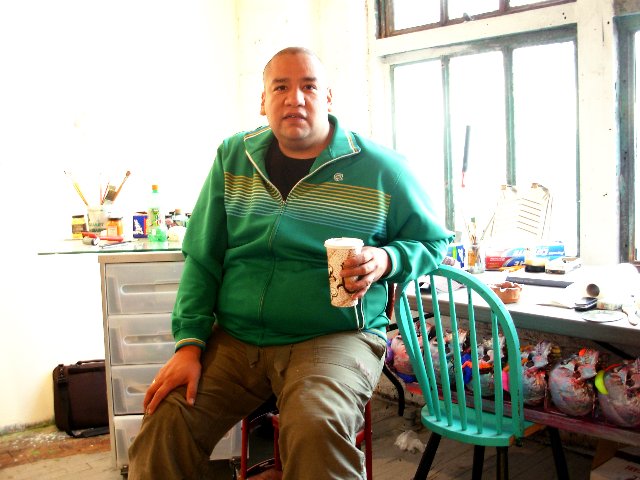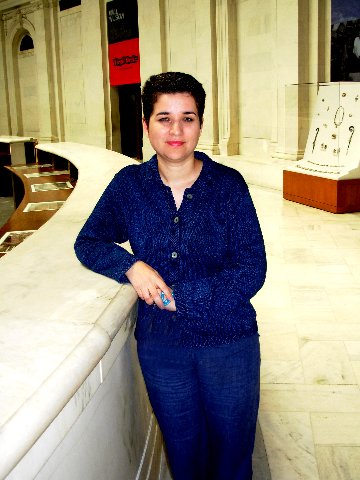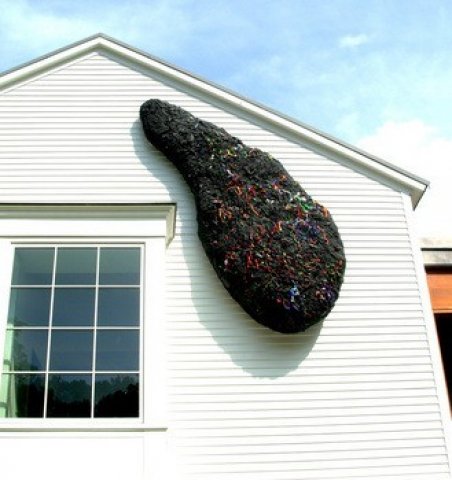Jeffrey Gibson at American Pavilion of Venice Biennale
Studio Visit in 2006 with Native American Artist
By: Charles Giuliano - Apr 21, 2024
In what is regarded as a landmark and breakthrough, the Native American artist, Jeffrey Gibson is featured in the American pavilion of the current Venice Biennale. The occasion focuses not just on the work but recognition of his heritage and culture.
In that regard America lags far behind Canada where First Nations art, past and present, has been recontextualized by its museums. Few mainstream American museums embrace that agenda although change has occurred in recent years. The special exhibition "Shame and Prejudice: A Story of Resilience" by the First Nations artist Kent Monkman was resonating. He later exhibited enormous canvases in the lobby of the Metropolitan Museum of Art.
There was backlash when the late Jimmie Durham was featured at the Whitney Museum of American Art. His claim to have been Native American was widely disputed. That wrong was righted with the Whitney’s 2023 retrospective of Jaune Quick-to-See Smith (born 1940) a Native American visual artist and curator. She is an enrolled member of the Confederated Salish and Kootenai Tribes and is also of Métis and Shoshone descent. She is an educator, storyteller, art advocate, and political activist.
Now Gibson (born 1971) has assumed a leadership role. We met in 2006 when he showed at Boston’s Samson Gallery directed by the visionary Camillo Alvarez.
At that time I was engaged with the culture and its issues. Jaune was my mentor and I curated an exhibition of new works on paper for the New England School of Art & Design/ Suffolk University. She presented a slide show overview of contemporary native artists in the Suffolk auditorium. Jaune also met for a talk with students in the gallery.
The university sponsored lecture was successful and energizing. I suggested to Dean of Students, Ken Greenberg, that is was an important niche not represented by the university. In a dismissive manner he responded that “There are many niches.” Why Native American issues are the last of many to be considered represents a complex and shameful legacy entailing racism and genocide. American students learn more about the Holocaust and slavery than the slaughter and sustained exploitation of resources and mistreatment of indigenous people.
Few if any mainstream curators or critics a generation ago were engaging with native culture. There was a sense of adventure as well as challenges. Part of that was overcoming limitations and prejudice as a Caucasian taking on a different and ancient tradition.
I saw myself as an intermediary willing to show significant and diverse work. The strategy was to let the art itself define how it was exhibited and evaluated. Familiar paradigms need not apply which is why so few risked taking on an agenda with few perks and little recognition. The dean, for example, saw no value in the dialogue I brought to the university. To me, bringing native art and culture to an academic gallery represented a great opportunity for education. Significantly, the native artists that I exhibited were not invited to the studios and classrooms of my colleagues. I curated a lively show "Native New Yorkers" which attracted no reviews. Mario Martinez was a part of that project.
My focus was on the work and I did not see myself as a cultural anthropologist. These academics descending on reservations were brilliantly satirized by Vine Deloria, Jr. Unlike them, I didn’t aspire to sit in sweat lodges. See also Paul Chaat Smith “Everything You Know About Indians is Wrong.” As an artist put it “You’ll never walk in our moccasins” which was never my aspiration.
Here are links to earlier exhibitions. Gibson displayed a relief on an exterior wall for the Aldrich Museum’s “No Reservations.” In Hudson. New York we reviewed "Postidentity" at Nicole Fiacco Gallery in Hudson, New York.
The learning curve was intense and insightful. Part of which, as Jaune advised me, was moving on from a Eurocentric and academic art historical approach. My intent was to view the work on its own terms in an unfamiliar context. As a pioneer exploring a cultural niche, there was much that I see more clearly now than on initial contact.
There were individuals who were welcoming and supportive. Not least was Kathleen Ash Milby, then curator of the National Museum of the American Indian-New York, the George Gustav Heye Center. When in New York I often visited the museum in lower Manhattan and discussed the artists. (“Fritz Scholder: Indian/ Not Indian, ”) Currently, she is the curator of Native American art at the Portland Art Museum and cocurator, with Abigail Winograd, of the U.S. pavilion for the 60th edition of the Venice Biennale.
As Gibson told the BBC "When I visited the pavilion a year ago, I asked myself, 'How is it that I can represent the United States, with all of its complicated and traumatic histories toward Native people?'" he recalls. "I don't think one person can truly represent an entire country. But in the best case, you can represent as earnestly as possible your relationship to these layered ideas of nationhood, of country, of Americanism, of Indigeneity...
"There are moments when I'm proud to be American, and there are also moments when I’m totally confounded," he says. "The promises of the United States can be invigorating in a way that many parts of the world have never experienced. But those promises have also been misinterpreted to empower some people and to disempower Native people. When the idea of 'nationalism' becomes divisive, it becomes problematic..."
"That interest [in Native cultures] is long overdue, but I do feel like it's going to have sustaining power," he says. "If you had asked me even a couple years ago, I would have wondered if it was just a trend. But in the moment we're in right now, I think it's very promising."
What follows is a report on a studio visit with Gibson which was published in Maverick Arts (precursor of Berkshire Fine Arts) 06/06/06. The text has been edited for reposting.
Right now there is a lot on the plate of the painter/sculptor Jeffrey Gibson. At the time of the recent studio visit in Brooklyn works were partly crated in preparation for a move just a couple of blocks away. By the end of August he is scheduled to install a relief sculpture, the largest and most ambitious of his career, for a group show “No Reservations” combining native and non native artists, curated by Richard Klein for the Aldrich Museum of Art in Ridgefield, Connecticut.
There is a solo show on tap for Samson Projects in Boston this fall. He will be in a group exhibition in March 2007 "Off the Map: Landscape in the Native Imagination" with James Lavadour, Emmi Whitehorse and Carlos Jacanamijoy, and an essay by Paul Chaat Smith, curated by Kathleen Ash Milby, at the Smithsonian’s National Museum of the American Indian in lower Manhattan. He is also scheduled to participate, this Fall, in group shows at the Westport Arts Center, in Connecticut, The Peekskill Project in New York, “Paumanok-a” for SUNY, Stonybrook, NY and “Tropicalism” at the Jersey City Museum. In addition, Samson Projects will continue to present works by Gibson in its itinerary of national and international art fairs.
The school year is over at Cooper Union where he has been an adjunct faculty member in the Outreach Program since 2004. So he is able to work full time in the new studio keeping up with all those commitments and deadlines. Since there was little evidence of new work I asked how he planned to meet the now looming Aldrich deadline for which the curator negotiated the donation of a significant amount of the silicone material for the project from a Connecticut based company. When asked how it was progressing he responded that it will get done, it always does. One measure of the success of this relatively young artist, who earned a Masters of Arts degree from London’s Royal College of Art in 1998, is that sales of art represent about half of his annual income.
There is a strong support system for this artist but that also equates to enormous pressure. The work is veering off in several directions from painting through sculpture and in between. It doesn’t always work and I didn’t hesitate to discuss critical issues with him.
My interest in the artist ratcheted up when I attended his presentation during a remarkable Native American panel during the College Art Association annual meeting in Boston this past Spring. It was compelling to learn and appreciate how dramatically the work had evolved during a relatively short interval of time. But there are also a daunting number of issues and differences: Generational, sexual, racial, cultural, that define and shape the work.
It is important to recognize and concede differences and, if you respect the artist and work, struggle to engage and resolve them. In the studio we attemptedd to negotiate a tough and complex dialogue particularly given Gibson’s multi-valent influences; like raves and ecstasy, or pow wows and fancy dancing.
“Personally, I grew up with ambivalence about being native,” he said. “It was a generational response. There was a sense of shame. We were given few models of successful individuals that included being native. For me being native is an idea of spirituality. My father is Mississippi Choctaw and my mother is Oklahoma Cherokee.”
The artist, who was born in 1972 in Colorado Springs is the son of a civil engineer who worked with the military. The family moved a lot including time in Europe. “When I first started to engage (with Native culture),” he said. “I was regarded as a city kid. I was close to my aunts and grandmother. As an adult in my 20s I was more engaged. When I was a student at the Art Institute of Chicago I worked part time at the Field Museum.”
As the son of a successful engineer Gibson had a different access and relationship to education than someone growing up embedded in a traditional culture. “My father was the breakthrough,” he said. “He was one of ten brothers. My parents went to Indian boarding schools and my grand parents were sharecroppers in Mississippi. Both grandfathers had drinking problems that led them to (sobriety) and becoming Southern Baptist ministers. They were preaching to Indians in Choctaw and Cherokee. My father’s first language is Choctaw and my mother’s is Cherokee. My grandfather would preach in ten churches over ten hours on a single Sunday.”
With maturity he grew closer to his heritage. “The best of Choctaw culture is what I represent,” he said. “My tribe opened a casino about a dozen years ago. Our chief, for the past fifty years, Phillip Martin, hired the same developers who worked with casinos in Vegas and other places. He also built one of the top five golf courses in the country. Thirty years ago he had a plan to bring business to Mississippi. There was pragmatism and the impulse not to make of the Choctaw some romantic notion. It was about risk management. When the casino opened he hired an all white management staff. He realized that in Mississippi race is an issue.”
This pragmatism paid off and the business plan succeeded. Although the local press carried racists reports that the Indians were “drinking up the profits.” After earning a BFA in Chicago Gibson had the idealistic notion that he would teach art on the reservation. But he was stunned when he was turned down and informed that he might reapply when he earned a master’s degree. This actually led to the Chief seeing that he was funded for the three years in London at the Royal College of Art. The Chief, whom Gibson describes as a remarkable visionary and savvy businessman, informed him that he was worth more to the tribe when grant writing and making government reports, as a grad student in London, than teaching art on the reservation. Gibson became an element of the success story of the Choctaws.
He describes having come to a point where he has tried to stop fighting himself; to overcome his “defeatism” and to “have a disregard for how people regard me as native.” Clearly that is daunting and he adds that “I want to respect the native community. I believe in being a hypocrite and making mistakes otherwise I could not move forward on a day to day basis. It is way too much work not to be myself and make the work I want to make. In terms of native culture I step slowly but I do not want to be compromised.”
So it has taken time and sweat equity to develop the work given such a range of restraints, inspiration, globalization, queer culture and other mandates. At the age of 34 he states that he has been making mature and serious work for a decade but only showing it for the past three years. Despite the level of critical and curatorial interest and sales he is still in the initial stages of building a professional career.
I wrote a critical piece about his first show at Samson Projects (run by gallerist Canillo Akvarez). It was difficult to revisit that dialogue. He listened intently and patiently as I reiterated those arguments. It seems he has heard it all before so there was a comic irony as he bounced it back as a parody. He reeled off the litany “Too lush. Too crafted. Too objectified. Too, too, too, too, too. But to respond how? To please who? You? The art world? Would that be careerist? Is my goal is to end up with a gallery in Chelsea? That said, what I want to see is extremely personal.”
He summarized how those terms and criticism are all too familiar and “comprise an analytical and critical statement against how persons of minority background with references to cultural objects in their work are referred to as ‘decorative.’ Did you ever attend a pow wow or see a fancy dancer ? If you did you could understand. The paintings relate to the whimsy objects of the 19th century which is what I talked about at CAA. To me the way that the figures are working are representation jammed up against pure abstraction. Up to now I have been very selfish in what I produce but I am more willing to consider other views.”
I was not prepared for what came next. We groped back to the issue of spirituality in his native identity and how that gets embedded in the work. He had already described his ambivalence about growing up native. The catharsis occurred when he worked at the Field Museum surrounded by its daunting collection and the collective wammy of all those ghosts and ancestors.
Part of his work at the museum was to prepare objects when representatives of tribes came to examine and potentially reclaim sacred objects. He worked with a staff anthropologist and there were elaborate protocols to be observed. This resulted in being present during remarkable moments. As he started to describe such incidents he lost his composure. The power of the objects and memory of those seminal moments was overwhelming. He expressed how much he truly believed in the intensity of the objects and their spirituality.
He described how early on, while alone in the storage area of the museum, he just lay down on the floor surrendering to and truly not knowing just what those surrounding objects would say and do to him. It was the ultimate existential moment of coming to grips with the power of the past
A moment and experience such as this renders rather irrelevant the usual studio visit. Rarely does a stranger get such glimpses into the humanity and vulnerability of another human being. It brought to the foreground the entire issue of just what such crucial historical, cultural and spiritual objects, of any religion and people, are doing in the collections of museums.
“Some objects are stronger than me,” he said. “I’m not afraid to say this as it is the truth.” It will be intriguing to follow how that primal essence gets embedded into and grows with the work.




